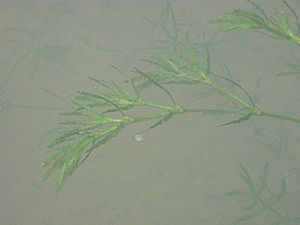Spiny water nymph facts for kids
Quick facts for kids Spiny water nymph |
|
|---|---|
 |
|
| Scientific classification | |
| Genus: |
Najas
|
| Species: |
marina
|
Najas marina is an aquatic plant often called the spiny water nymph, spiny naiad, or holly-leaved naiad. This plant is found all over the world! You can see it in Europe, Asia, Africa, Australia, the Americas, and even on many islands. It grows in different kinds of freshwater and brackish (slightly salty) places, including water that is a bit alkaline.
What Does the Spiny Water Nymph Look Like?
The spiny water nymph is a plant that lives for only one year. It has a thin stem that branches out, growing up to 40 or 45 centimeters long. Its leaves are spaced out evenly and can be up to 4 centimeters long and 1 to 3 millimeters wide.
The edges of the leaves have tiny teeth, like a saw. The middle part of the leaf also has small prickles. Tiny green flowers grow where the leaves meet the stem. This plant is special because it is dioecious. This means that male flowers and female flowers grow on separate plants. In some places, like the British Isles, it seems only female plants grow. The plant usually flowers in the middle of summer.
Where Does the Spiny Water Nymph Live?
The spiny water nymph is found in many places around the world, in both warm (tropical) and cooler (temperate) areas. It likes water that has a medium amount of nutrients, often over deep mud or peat.
In the British Isles, this plant was first seen in 1883 in a place called Hickling Broad. Over time, its numbers went down in the 1960s because of pollution. But people worked hard to clean up the water in the Norfolk Broads, and now the water quality is much better.
Ancient Spiny Water Nymphs
Scientists have found a fossil seed of Najas marina! This ancient seed was found in samples taken from a deep hole in Poland. It came from freshwater deposits that are from the Middle Miocene period, which was millions of years ago.

